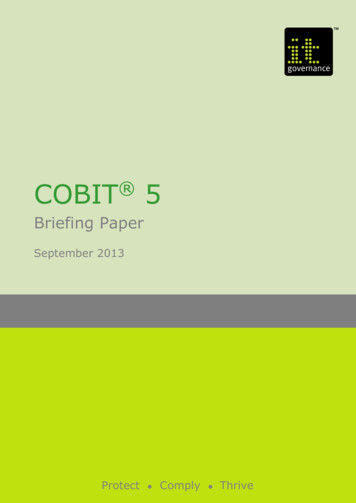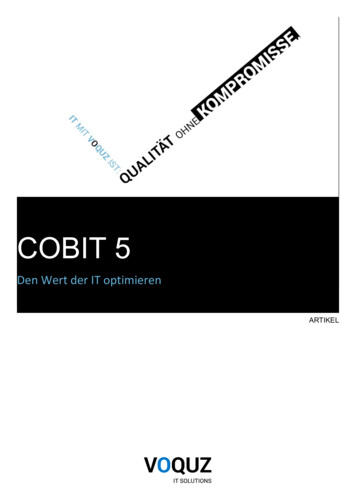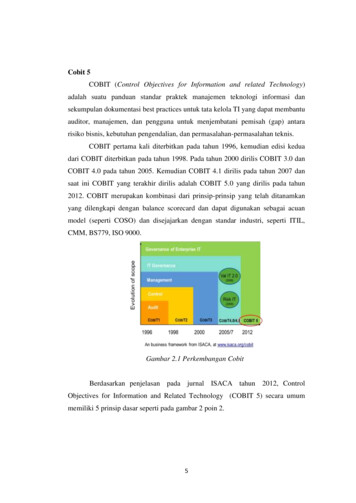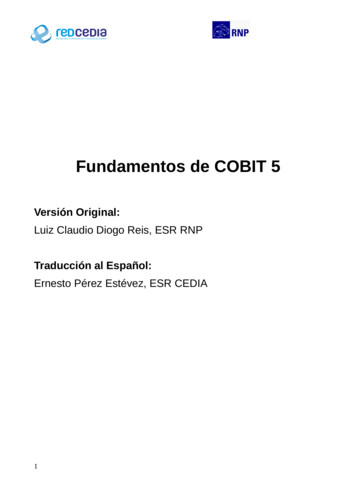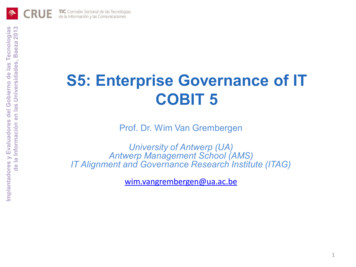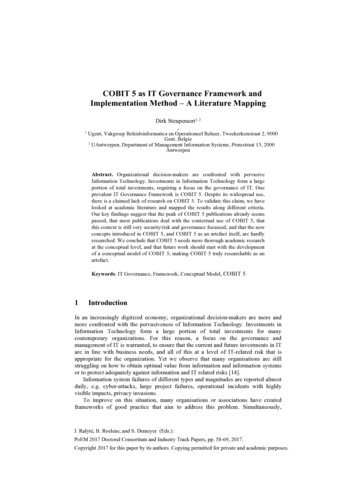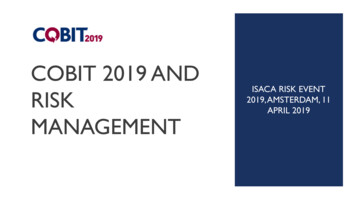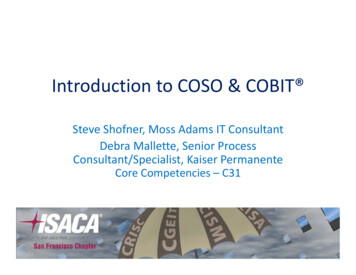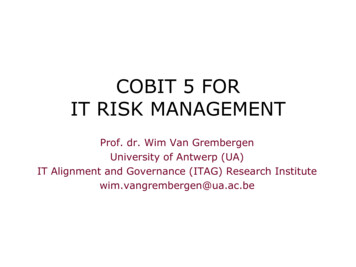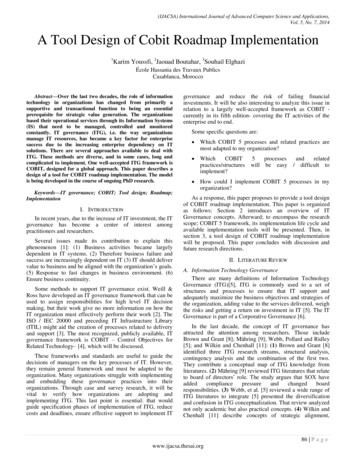
Transcription
(IJACSA) International Journal of Advanced Computer Science and Applications,Vol. 5, No. 7, 2014A Tool Design of Cobit Roadmap Implementation1Karim Youssfi, 2Jaouad Boutahar, 3Souhail ElghaziÉcole Hassania des Travaux PublicsCasablanca, MoroccoAbstract—Over the last two decades, the role of informationtechnology in organizations has changed from primarily asupportive and transactional function to being an essentialprerequisite for strategic value generation. The organizationsbased their operational services through its Information Systems(IS) that need to be managed, controlled and monitoredconstantly. IT governance (ITG), i.e. the way organizationsmanage IT resources, has became a key factor for enterprisesuccess due to the increasing enterprise dependency on ITsolutions. There are several approaches available to deal withITG. These methods are diverse, and in some cases, long andcomplicated to implement. One well-accepted ITG framework isCOBIT, designed for a global approach. This paper describes adesign of a tool for COBIT roadmap implementation. The modelis being developed in the course of ongoing PhD research.Keywords—IT governance; COBIT; Tool design; Roadmap;ImplementationI. INTRODUCTIONIn recent years, due to the increase of IT investment, the ITgovernance has become a center of interest amongpractitioners and researchers.Several issues made its contribution to explain thisphenomenon [1]: (1) Business activities became largelydependent in IT systems. (2) Therefore business failure andsuccess are increasingly dependent on IT (3) IT should delivervalue to business and be aligned with the organization’s goals.(5) Response to fast changes in business environment. (6)Ensure business continuity.Some methods to support IT governance exist. Weill &Ross have developed an IT governance framework that can beused to assign responsibilities for high level IT decisionmaking, but their work give no more information on how theIT organization must effectively perform their work [2]. TheISO / IEC 20000 and preceding IT Infrastructure Library(ITIL) might aid the creation of processes related to deliveryand support [3]. The most recognized, publicly available, ITgovernance framework is COBIT – Control Objectives forRelated Technology– [4], which will be discussed.These frameworks and standards are useful to guide thedecisions of managers on the key processes of IT. However,they remain general framework and must be adapted to theorganization. Many organizations struggle with implementingand embedding these governance practices into theirorganizations. Through case and survey research, it will bevital to verify how organizations are adopting andimplementing ITG. This last point is essential: that wouldguide specification phases of implementation of ITG, reducecosts and deadlines, ensure effective support to implement ITgovernance and reduce the risk of failing financialinvestments. It will be also interesting to analyze this issue inrelation to a largely well-accepted framework as COBIT currently in its fifth edition- covering the IT activities of theenterprise end to end.Some specific questions are: Which COBIT 5 processes and related practices aremost adapted to my organization? andrelatedwill be easy / difficult to How could I implement COBIT 5 processes in myorganization?As a response, this paper proposes to provide a tool designof COBIT roadmap implementation. This paper is organizedas follows: Section 2 introduces an overview of ITGovernance concepts. Afterward; to encompass the researchscope; COBIT 5 framework, its implementation life cycle andavailable implementation tools will be presented. Then, insection 3, a tool design of COBIT roadmap implementationwill be proposed. This paper concludes with discussion andfuture research directions.II. LITERATURE REVIEWA. Information Technology GovernanceThere are many definitions of Information TechnologyGovernance (ITG)[5], ITG is commonly used to a set ofstructures and processes to ensure that IT support andadequately maximize the business objectives and strategies ofthe organization, adding value to the services delivered, weighthe risks and getting a return on investment in IT [5]. The ITGovernance is part of a Corporative Governance [6].In the last decade, the concept of IT governance hasattracted the attention among researchers. Those includeBrown and Grant [8]; Mähring [9]; Webb, Pollard and Ridley[5]; and Wilkin and Chenhall [11]: (1) Brown and Grant [8]identified three ITG research streams, structural analysis,contingency analysis and the combination of the first two.They contribute a conceptual map of ITG knowledge fromliteratures. (2) Mähring [9] reviewed ITG literatures that relateto board of directors’ role. The study argues that SOX bilities. (3) Webb, et al. [5] reviewed a wide range ofITG literatures to integrate [5] presented the diversificationand confusion in ITG conceptualization. That review analyzednot only academic but also practical concepts. (4) Wilkin andChenhall [11] describe concepts of strategic alignment,86 P a g ewww.ijacsa.thesai.org
(IJACSA) International Journal of Advanced Computer Science and Applications,Vol. 5, No. 7, 2014performance measurement, risk management, and valuedelivery as the most significant enablers of IT governance.They note that broader organizational structures, businessprocesses and technology, and resource capabilities influencethe enablers and by extension IT governance.COBIT provides an integration guideline to use with otherframeworks. Principle 4 shows how ITG components relatesand provide a set of critical success factors (they are calledenablers). Principle 5 shows that COBIT 5 clearly separategovernance and management.Many researchers also attempt to propose various ITGmodels and concepts (e.g. Van Grembergen and De Haes [12],Weill and Ross [10], Brown and Grant [6]).In the practitioner arena, there are a various versions offrameworks and standards dealing with the ITG: ISO/IECStandard 38500, ITIL V3, and COBIT, for instance, COBIThas been recognized as the most used framework [7].Past literature reviews indicate different viewpoints andconceptual diversification in ITG field of studies, essentially,when different research communities differently conceptualizeITG. One outstanding finding is that ITG is constantlyevolving. Since there are regular introductions of newconcepts, legal requirements, standards and practicalframeworks. It is vital not to ignore these changes in order togain better understanding of ITG field.COBIT 5, the latest version of COBIT [13] is recentlyintroduced, in this context the next section proposes to explorethe IT Governance concepts in COBIT 5.TABLE I.COBIT 5 PRINCIPLES [13]PrinciplesPrinciple 1 - Meeting Stakeholder NeedsPrinciple 2 - Covering the Enterprise End-to-EndPrinciple 3 - Applying a Single Integrated FrameworkPrinciple 4 - Enabling a Holistic ApproachPrinciple 5 - Separating Governance from ManagementThese principles demonstrate scope, how-to and objectivesof COBIT. They highlight on certain concepts, such as, goalcascade and governance enablers.From operational point of views, COBIT 5 provides 37processes in two domains. The governance domain containsfive processes while management domain contains 32processes. These processes are provided as a guideline topractitioners. Fig. 1 shows key governance and managementareas and Table II shows COBIT processes.B. IT Governance Concepts in COBIT 5COBIT is the framework for governance and managementof IT developed by ISACA, which evolved into the currentversion “COBIT 5”- released in 2012, designed to be a singleintegrated framework [13]. COBIT 5 defines governance as:“Governance ensures that stakeholder needs, conditionsand options are evaluated to determine balanced, agreed-onenterprise objectives to be achieved; setting direction throughprioritization and decision making; and monitoringperformance and compliance against agreed-on direction andobjectives.” [13].This definition is different from the previous versions ofCOBIT. It recognizes multiple stakeholders of organizationalIT as well as balance of resources distribution while maintainoverall firm goals. Second, it explicitly states what activitiesto do. Third, this no mentions about leadership, structures andprocesses in the definition [14].COBIT 5 reveals new conceptual ideas compared toprevious versions. COBIT 5 proposes COBIT principles,which guide the governance of IT. The five principles include:Meeting Stakeholder Needs; Covering Enterprise End-to-end;Applying a Single, Integrated Framework; Enabling a HolisticApproach; and separating Governance from Management [14]as in Table I. Principle 1 emphasizes on goal cascade andvalue creation among different stakeholders who may expectdifferent IT value. Principle 2 exhibits that COBIT does notlimit to IT department but it covers entire enterprise. COBITincludes guide for integration to corporate governance forvalue creation by specifying roles, activities and relationships.Principle 3 indicates that COBIT aims to be the umbrellaframework.Fig. 1. Cobit 5 Governance and Management Areas [13]COBIT 5 indicates that governance processes will providedirection to management processes based on business needs.Then, governance processes will get feedback frommanagement processes to evaluate how well the directions arecarried out or whether they are needed to be adjusted.Governance actions include Evaluate, Direct and Monitoror EDM. COBIT 5 sees board of directors is accountable forgovernance processes while executives are responsible toperform them. EDM and board accountability concepts aresimilar to ISO38500 [10].On the other hand, management processes are categorizedby IT life cycle. There are four areas: Align, Plan andOrganize (APO); Build, Acquire and Implement (BAI);Deliver, Service and Support (DSS); and Monitor, Evaluateand Assess (MEA).87 P a g ewww.ijacsa.thesai.org
(IJACSA) International Journal of Advanced Computer Science and Applications,Vol. 5, No. 7, 2014Each area contains different processes. COBIT 5 sees thatAPO and MEA areas are directly linked to governanceprocesses. These process areas contain different ITGactivities.COBIT 5 is not a minor update to its previous version.There are conceptual differences, new emphasizes and newarrangements. These distinctions could imply or effectgovernance practice and knowledge in many ways.TABLE II.AreaEDMAPOBAIDSSMEACOBIT 5 PROCESS [14]ProcessEDM1 Set and Maintain the Governance FrameworkEDM2 Ensure Value OptimizationEDM3 Ensure Risk OptimizationEDM4 Ensure Resource OptimizationEDM5 Ensure Stakeholder TransparencyAPO1 Define the Management Framework for ITAPO2 Manage StrategyAPO3 Manage Enterprise ArchitectureAPO4 Manage InnovationAPO5 Manage PortfolioAPO6 Manage Budget and CostAPO7 Manage Human ResourcesAPO8 Manage RelationshipsAPO9 Manage Service AgreementsAPO10 Manage SuppliersAPO11 Manage QualityAPO12 Manage RiskAPO13 Manage SecurityBAI1 Manage Programs and ProjectsBAI2 Define RequirementsBAI3 Identify and Build SolutionsBAI4 Manage Availability and CapacityBAI5 Manage Organizational Change EnablementDeliver, Service and SupportBAI6 Manage ChangesBAI7 Manage Change Acceptance and TransitioningBAI8 Manage KnowledgeBAI9 Manage AssetsBAI10 Manage ConfigurationDSS1 Manage OperationsDSS2 Manage Service Requests and IncidentsDSS3 Manage ProblemsDSS6 Manage ContinuityDSS5 Manage Security ServicesDSS6 Manage Business Process ControlsMEA1 MEA Performance and ConformanceMEA2 MEA the System of Internal ControlMEA3 MEA Compliance with External RequirementsFig. 2. Seven Phases of the Implementation Life Cycle[14]Phase 1—What Are the Drivers?Phase 1 identifies current change drivers and creates atexecutive management levels a desire to change.Key Questions, which need to be answered in this phase,include: What is the business motivation and justification?What are the Stakeholder needs and expectations that need tobe satisfied? Why are we doing this?There must be consensus on the need for implementingCOBIT 5, to change and improve, supported by the will andcommitment of executive management.Dimensions: Program Management – Initiate the Program Change Enablement – Establish the desire to change Continual Improvement Lifecycle – Recognize theneed to act.C. COBIT 5 Implementation life cycleCOBIT 5 has a professional guide for implementation. Theguide provides details of seven phases of the implementationlife cycle, applying a continual improvement life cycleapproach provides a method for enterprises to address thecomplexity and challenges typically encountered during ITGimplementation [14]. There are three interrelated dimensionsto the life cycle, as illustrated in figure 2: the core ITGcontinual improvement life cycle, the enablement of change(addressing the behavioral and cultural aspects of theimplementation or improvement), and the management of theProgram. The three aforementioned dimensions exist withineach and every one of these phasesThe seven phases of the implementation life cycle areillustrated in figure 2.Phase 2—Where Are We Now?Phase 2 aligns IT-related objectives with enterprisestrategies and risk, and priorities the most important enterprisegoals, IT-related goals and processes. COBIT 5 provides ageneric mapping of enterprise goals to IT-related goals to ITprocesses to help with the selection. Given the selectedenterprise and IT-related goals, critical processes are identifiedthat need to be of sufficient capability to ensure successfuloutcomes. Management needs to know its current capabilityand where deficiencies may exist. This is achieved by aprocess capability assessment of the as-is status of the selectedprocesses.Dimensions:88 P a g ewww.ijacsa.thesai.org
(IJACSA) International Journal of Advanced Computer Science and Applications,Vol. 5, No. 7, 2014 Program ManagementOppo
COBIT 5 has a professional guide for implementation. The guide provides details of seven phases of the implementation life cycle, applying a continual improvement life cycle approach provides a method for enterprises to address the complexity and challenges typically encountered during ITG implementation [14]. There are three interrelated dimensions to the life cycle, as illustrated in figure .
